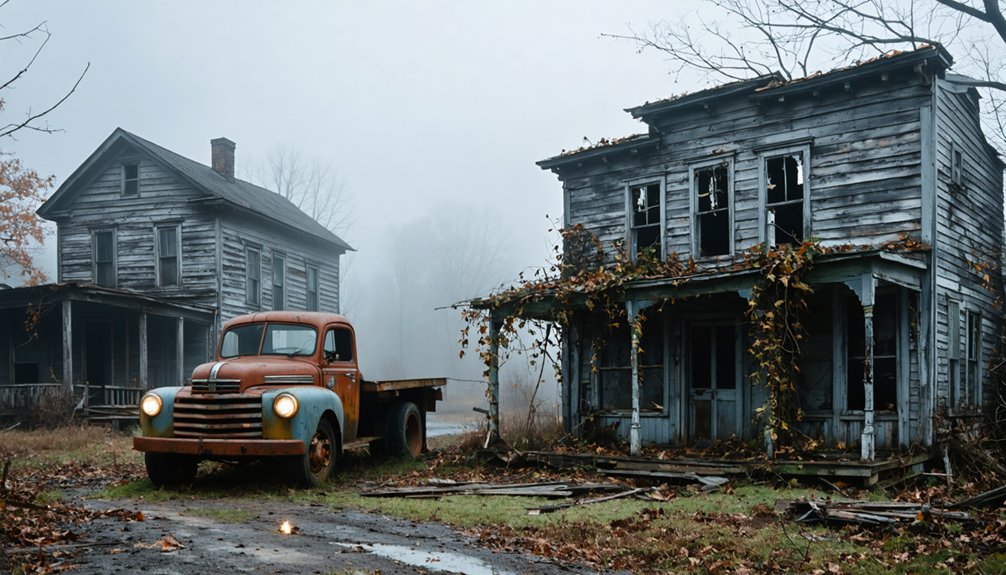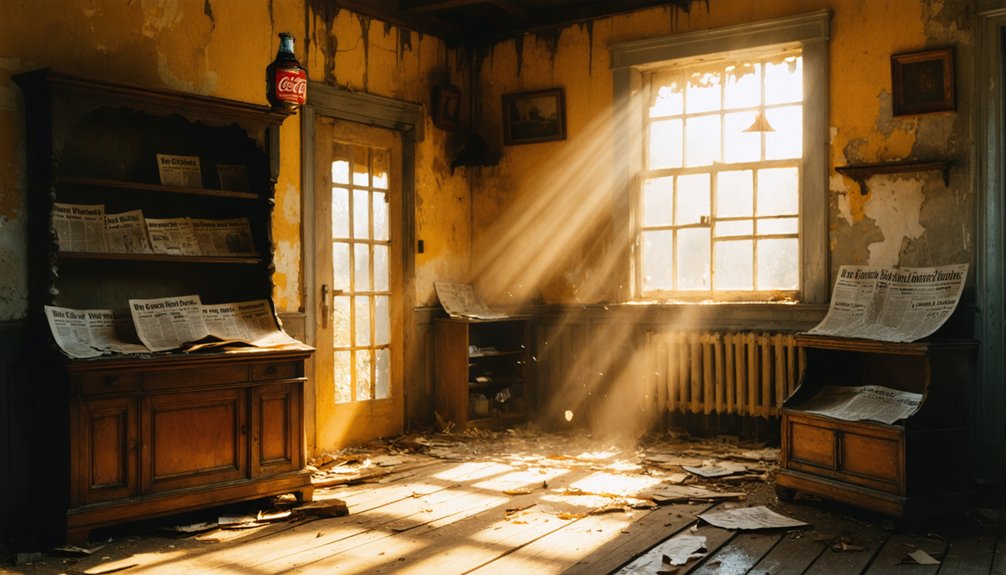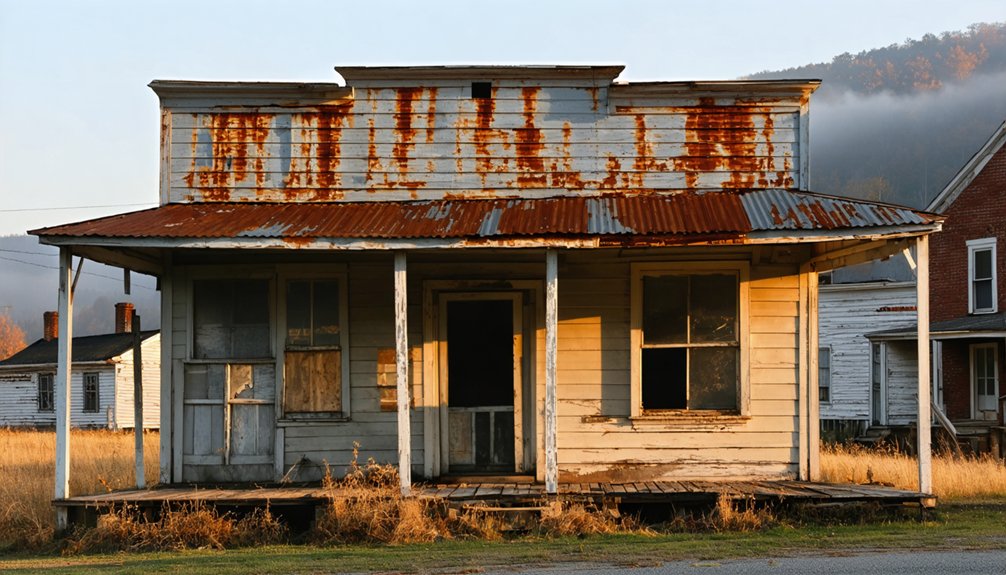You’ll find the remains of Camp Nelson, a vital Civil War Union Army base, in Jessamine County, Kentucky. Established in 1863, this 4,000-acre military installation served as both a vital supply depot and a refuge for escaped slaves. While the original camp structures are gone, the site’s rich history lives on through preserved earthen forts and the nearby community of Hall, founded by freed families. The grounds hold countless untold stories of triumph and tragedy.
Key Takeaways
- Camp Nelson transformed from a 4,000-acre Civil War military base to largely abandoned land after its closure in 1866.
- The original military infrastructure was dismantled or abandoned when troops and refugees dispersed following the war’s end.
- After military operations ceased, the land reverted to agricultural use without developing into a significant civilian settlement.
- While Camp Nelson itself became abandoned, the nearby community of Hall emerged as home to freed families.
- The site’s ghostly remnants include earthen fort foundations and scattered structural ruins from its military past.
The Birth of a Military Stronghold
As the Civil War intensified in 1863, Camp Nelson emerged as an important Union military stronghold under General Ambrose Burnside’s strategic vision.
You’ll find this remarkable site perched on a plateau above the Kentucky River, just 20 miles south of Lexington, where nature provided the perfect defensive position with steep drops on three sides.
The military strategy behind Camp Nelson’s location proved brilliant.
You’re looking at a site that controlled key transportation routes along the Lexington-Danville Turnpike and maintained essential connections to Nicholasville, Lexington, and Richmond.
Despite logistical challenges, the camp grew to span 4,000 acres, featuring an intricate network of eight earthen forts.
This positioning allowed Union forces to consolidate troops and supplies centrally in Kentucky, supporting critical operations into East Tennessee.
Named in honor of Major General William Bull Nelson, the camp established itself as a crucial supply depot for Union advances.
The camp quickly became one of the largest recruitment centers for African American soldiers who sought to fight for the Union cause.
A Beacon of Hope for Escaped Slaves
Beyond its military significance, Camp Nelson transformed into a powerful symbol of freedom for enslaved people seeking refuge from bondage.
As freedom journeys brought increasing numbers of escaped slaves to the camp after the Emancipation Proclamation, you’d find a growing community of resilient individuals rebuilding their lives.
Despite harsh conditions and overcrowding, the camp provided essential services like healthcare and education, helping families reunite and establish new beginnings.
The community resilience displayed at Camp Nelson influenced local attitudes toward slavery, as interactions between refugees and residents fostered understanding.
You’ll discover that while refugees faced numerous challenges, including disease and inadequate housing, they found strength in unity.
The camp’s expanding facilities and support systems made it a model for other refugee camps, demonstrating the power of hope in the face of adversity.
Life Within the Union Supply Depot
You’ll find Camp Nelson’s daily operations centered around its bustling supply depot, where soldiers managed vast quantities of food, ammunition, and equipment for distribution to Union forces.
The wooden barracks and tents housed troops in often crowded conditions, with soldiers following strict routines of drills and maintenance duties between supply runs.
A field hospital provided essential medical care, though the staff frequently struggled with limited resources while treating wounded soldiers and managing disease outbreaks that threatened the camp’s population.
Daily Supply Operations
During the Civil War, Camp Nelson’s supply depot operated like a well-oiled machine, with quartermaster officers coordinating a complex network of daily operations to sustain both troops and refugees.
The depot’s supply logistics involved meticulous tracking of food, ammunition, clothing, and equipment through detailed inventory logs and distribution schedules.
You’d find quartermasters overseeing ration management, ensuring soldiers and refugees received their daily portions of salt pork, hardtack, and coffee.
They’d coordinate with railroads and wagon trains to maintain steady supply flows, while local freedmen helped with loading and unloading goods.
The clothing depot kept uniforms and equipment in good repair, while secure bunkers housed ammunition under strict protocols.
Despite occasional shortages from supply line disruptions or weather challenges, the depot’s strategic location made it an essential hub for the Union Army.
Barracks and Medical Care
Life within Camp Nelson’s barracks revealed the stark realities of Civil War military housing and healthcare. You’d find hastily constructed timber buildings with rows of bunk beds, where dozens of soldiers endured harsh temperatures and poor ventilation.
These barrack conditions often led to widespread illness among troops.
The camp’s field hospital tackled medical challenges head-on, with dedicated surgeons and nurses working around the clock. You’d see medical staff, including freedmen and formerly enslaved African Americans, treating everything from battle wounds to typhoid fever.
They operated with limited supplies and primitive surgical methods, yet maintained strict quarantine protocols for infectious diseases.
Recovery meant long stays in basic wards, where patients relied on simple nutrition, rest, and occasional letters from fellow soldiers to maintain their spirits.
The Dark Days of Forced Expulsions
You’ll find one of Camp Nelson’s darkest chapters in the military’s forced expulsion of African American soldiers’ families, which sent vulnerable refugees into the brutal winter of 1864 without shelter or provisions.
Local communities watched in horror as women and children suffered through freezing conditions, with many perishing from exposure and illness.
The tragedy sparked immediate outrage from abolitionists and concerned citizens, whose protests eventually forced the army to establish refugee housing and reverse its inhumane expulsion orders.
Military Orders Spark Tragedy
What began as a refuge for escaped enslaved people turned into a site of devastating tragedy when military leadership at Camp Nelson issued orders to forcibly remove thousands of African American families in late 1864.
Under General Speed S. Fry’s command, these expulsions revealed the harsh reality of racial prejudice masquerading as military justice.
- Armed soldiers forced women and children from their shelters in brutal winter conditions
- Families were torn apart, leaving many without food, clothing, or protection
- Children and elderly refugees died from exposure and starvation
- Some sympathetic officers quietly resisted or ignored removal orders
- Military leaders justified these actions by claiming resource shortages and security concerns
The expulsions shattered the trust between African American communities and Union forces, creating wounds that would take generations to heal.
Refugees Face Brutal Winter
During the brutal winter of 1864-1865, Camp Nelson’s refugee population faced unimaginable hardships as temperatures plummeted and resources dwindled.
As winter struggles intensified, you’d have witnessed over 10,000 refugees battling severe cold, inadequate shelter, and devastating food shortages. Disease outbreaks ravaged the camp while frozen water sources and overcrowded conditions accelerated the spread of typhoid fever and dysentery.
Despite refugee resilience, military authorities ordered forced expulsions, compelling families to march through freezing conditions without proper clothing or shelter.
You’d have seen the heartbreaking separation of families and devastating loss of life, particularly among children and the elderly. The government’s delayed response and insufficient aid left the community to face these brutal conditions largely on their own, leading to widespread tragedy and lasting trauma.
Community Rallies For Change
As forced expulsions threatened to tear apart Camp Nelson’s refugee community in 1865, local Black leaders and their allies mounted a fierce resistance against the cruel displacement policies.
Their community activism sparked a movement that you’ll recognize in historical memory as a reflection of collective resilience.
- Religious groups coordinated emergency shelter networks for displaced families
- Black community leaders documented abuses through formal petitions to federal authorities
- Abolitionists spread awareness through newspaper coverage and letter-writing campaigns
- Local organizers established support systems to protect vulnerable refugees
- Community pressure led to temporary relief measures from Washington
The grassroots response demonstrated the power of organized resistance, even as displaced families faced overwhelming odds.
While the expulsions continued, the community’s unified voice guaranteed their struggle wouldn’t be forgotten.
Triumph and Tragedy at the Refugee Home
The establishment of Camp Nelson’s Refugee Home in 1864 marked both a pivotal humanitarian triumph and heart-wrenching tragedy in Kentucky’s Civil War history.
You’ll find resilience stories of 10,000 formerly enslaved people who built a community amid devastating hardships, creating schools, churches, and support networks despite severe deprivation.
Yet the community struggles were overwhelming. In crowded, unsanitary conditions, families battled disease outbreaks, malnutrition, and harsh winters with minimal resources.
The death toll mounted as medical staff fought desperately against epidemics with insufficient supplies. While education and vocational programs offered hope for self-sufficiency, government support dwindled over time.
Despite valiant medical efforts against spreading disease, hope flickered through education programs even as government aid faded away.
The camp’s closure in late 1864 forced many refugees to face new uncertainties, leaving behind both inspiring tales of determination and sobering reminders of wartime suffering.
The Buffalo Soldiers’ Legacy
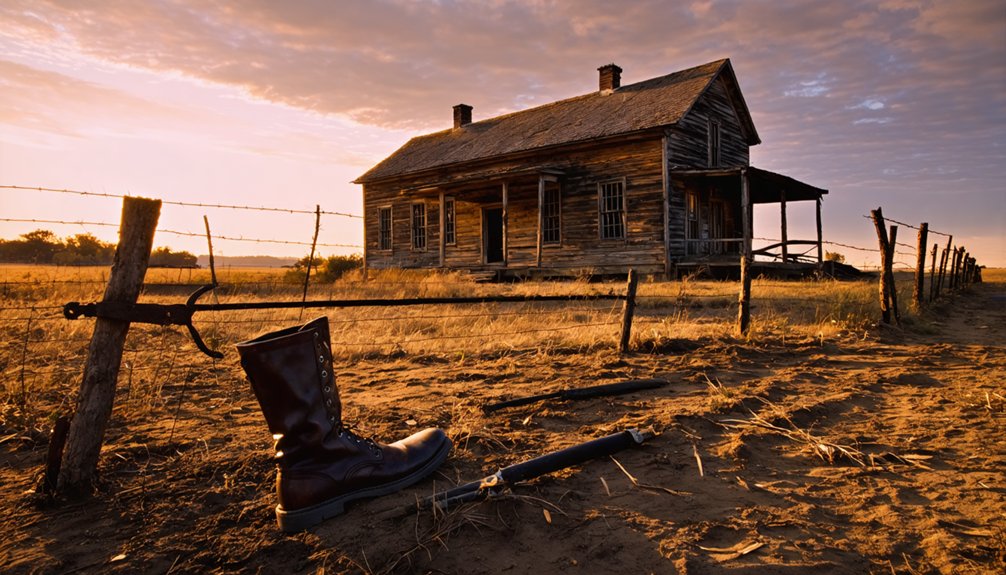
Rising from the ashes of Civil War tragedy, Buffalo Soldiers emerged at Camp Nelson as pioneering African American regiments in the U.S. Army.
Despite facing brutal discrimination and systemic racism, these brave soldiers played an essential role in protecting freedmen and maintaining order at the camp, paving the way for future military integration.
- Provided security and stability for refugee families seeking safety
- Demonstrated exceptional service during Reconstruction while facing harsh conditions
- Mentored fellow African American troops and served as role models
- Received lower pay and fewer promotions but maintained unwavering dedication
- Established a legacy of valor that advanced civil rights through military service
Today, Camp Nelson honors their contributions through memorials and educational programs, ensuring their story of courage and resilience continues to inspire future generations.
From Military Base to Ghost Town
Following its essential role during the Civil War, Camp Nelson‘s transformation into a ghost town began with the US Army’s official closure in summer 1866.
You’ll find the military transformations were swift and decisive – most infrastructure was dismantled, repurposed, or abandoned as troops and refugees dispersed from the once-bustling camp.
Despite its historical significance as one of the nation’s largest US Colored Troops recruitment centers, the site gradually faded into obscurity.
The land returned to agricultural use, and no major civilian settlement emerged to replace the military presence.
By the late 19th century, only scattered remnants remained – overgrown earthworks, old foundations, and abandoned wells marking where thousands once lived, trained, and sought freedom.
The site lay largely forgotten until preservation efforts began in the 1980s.
The Enduring Community of Hall
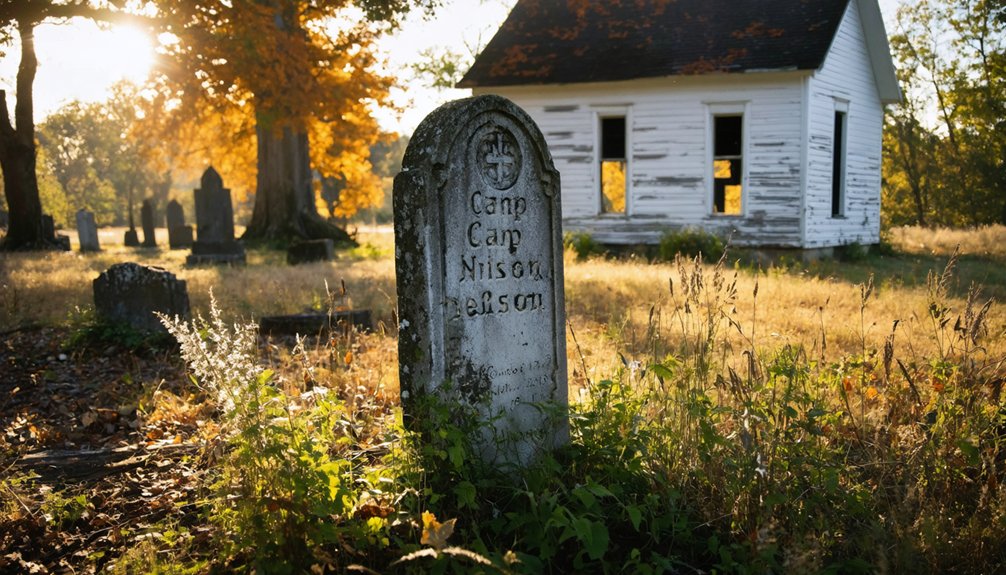
While Camp Nelson faded into abandonment, a resilient African American community known as Hall emerged nearby, establishing deep roots that continue to this day. Founded by freed families seeking stability after the Civil War, Hall demonstrates remarkable community resilience through generations of challenges.
You’ll find a tight-knit society where cultural heritage thrives through church gatherings, folk traditions, and oral histories passed down by community elders.
- Multi-generational families maintain strong ties to their agricultural heritage
- Local churches and schools serve as essential centers of community life
- Residents blend African American and Appalachian cultural traditions
- Community organizations work to preserve historical connections to Camp Nelson
- Despite rural isolation, Hall’s people sustain their identity through shared traditions and mutual support
Preserving a Sacred Ground
As a demonstration of its profound historical significance, Camp Nelson has earned recognition from the National Park Service and continues to draw preservation efforts from multiple stakeholders.
You’ll find historical preservation initiatives spanning archaeological research, site restoration, and protection of sacred grounds that once served as a vital refuge for African American soldiers and their families during the Civil War.
Through robust community engagement, you can participate in educational programs, guided tours, and commemorative events that honor the site’s legacy.
Local volunteers work alongside conservation organizations to maintain the grounds, while state and federal grants support ongoing restoration projects.
The site’s extensive documentation, including photographs, personal accounts, and artifacts, guarantees that Camp Nelson’s role in emancipation and African American military service remains vivid for future generations.
Frequently Asked Questions
What Happened to Camp Nelson’s Original Buildings and Fortifications?
You’ll find the original architecture deteriorated naturally and was dismantled for reuse in local buildings, while flooding and weather took their toll until modern preservation efforts began protecting remaining structures.
Were There Any Documented Confederate Attacks on Camp Nelson?
You won’t find records of direct Confederate attacks on Camp Nelson. While Confederate raids and military skirmishes occurred in surrounding areas, the camp’s strong defenses and Union presence deterred any major assaults.
What Diseases Were Most Common Among Refugees at Camp Nelson?
You’d have found severe disease outbreaks among Camp Nelson’s refugees, including measles, smallpox, tuberculosis, and typhoid fever. Poor sanitation and overcrowded conditions worsened these illnesses, devastating refugee health.
Did Any Notable Civil War Generals Visit or Command at Camp Nelson?
Truth be told, you won’t find famous Civil War generals like Grant or Sherman at Camp Nelson. Military leaders there were mid-ranking officers, with Colonel Clark and Colonel Fry serving as primary commanders.
How Did Local White Residents Interact With Camp Nelson During Operations?
You’ll find local whites maintained hostile community relations with Camp Nelson, resenting Union control and Black soldiers. They filed complaints, lost property to requisitions, and sometimes collaborated with Confederate guerrillas during wartime perceptions.
References
- https://www.nps.gov/cane/learn/historyculture/overview-of-camp-nelson.htm
- https://www.nps.gov/cane/learn/photosmultimedia/then-and-now.htm
- https://www.lex18.com/spotlight-series/spotlight-on-nicholasville-the-influence-of-african-americans-at-camp-nelson
- https://filsonhistorical.org/wp-content/uploads/publicationpdfs/63-4-3_Camp-Nelson-Kentucky-During-the-Civil-War-Cradle-of-Liberty-or-Refugee-Death-Camp_Lucas-Marion-B..pdf
- https://en.wikipedia.org/wiki/Camp_Nelson_National_Monument
- https://www.youtube.com/watch?v=4CLiDvBmVL4
- https://www.nps.gov/media/video/view.htm?id=5EBBEB67-3C93-4BE6-8AEC-8D34A9FE89A4
- https://history.ky.gov/markers/camp-nelson
- https://npshistory.com/publications/cane/index.htm
- https://www.presidency.ucsb.edu/documents/proclamation-9811-establishment-the-camp-nelson-national-monument
